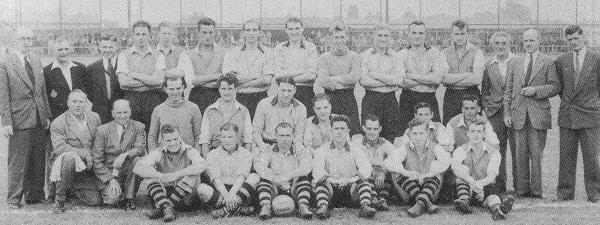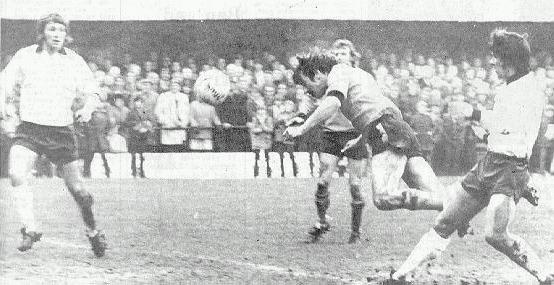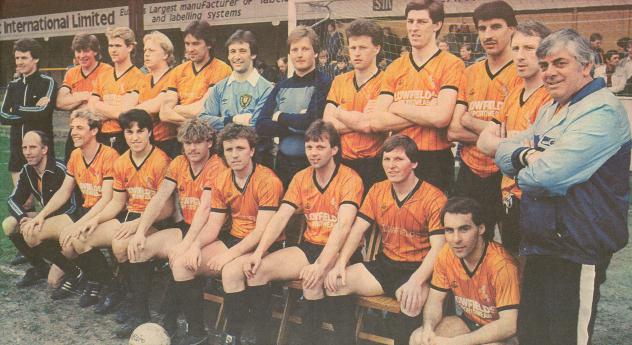The Boston United Story
Although it was 1933 before the name Boston United first appeared, football
had been played in the town since the late 1800's and, indeed, always on the
same site as the present York Street stadium. The first time that a team from
Boston entered the FA Cup was in 1887. In the first round they were drawn against
Gainsborough Trinity and were soundly thrashed 7-0. Those early years saw some
spectacular defeats in the FA Cup, including a 9-0 defeat at Lincoln City in
1890 and in the following season Grimsby Town went one better to notch up a
10-0 win.
By the start of the First World War there were two clubs in Boston: Boston
Town, whose headquarters were "The Coach and Horses", and Boston Swifts,
who used "The Indian Queen" as their H.Q. In fact, as both the public
houses were situated on "Main Ridge" and the pitch was virtually just
opposite, it wasn't surprising that for the first 40 years or so that was what
the Ground was called. A small stand was erected in the early 1900's but other
than that there were no other facilities, and the teams changed at the back
of the appropriate pub! Both teams were members of the Lincoln & District
League.
After the First World War only one club, called simply Boston, emerged. After
winning the Lincoln & District League in successive seasons, in 1921 the
club joined the Midland League as a semi-professional side. In 1925 it went
on to achieve the first Boston giant-killing in the F.A. Cup by beating the
then powerful Football League club Bradford Park Avenue 1-0 in the second round.
The club was also achieving respectable positions in the Midland League, being
runners up in 1924/5, behind Mansfield Town and again in 1926/7 behind Scunthorpe
United. Both Mansfield and Scunthorpe were non-league sides at this time. With
entrances and dressing rooms at the west end, the ground was now known as "Shodfriars
Lane".
At the end of the 1932/3 season the directors of Boston FC decided to wind
up the club and they took the company into liquidation. Lack of success had
meant that the club was not bringing in sufficient funds to make continuation
of the Midland League side financially viable. It was proposed to keep football
present in the town by running an amateur team in the Peterborough League. On
3rd July a group of Boston FC supporters held a meeting in the Friendly Societies
Hall to discuss an alternative proposal - to form a new club, to be called Boston
United, that would take the place of Boston FC in the Midland League. There
was enough support for the new proposal, so the new club was born and began
playing in the summer of 1933. It was able to replace Boston FC in the Midland
League and the Lincolnshire League, but was unable to get agreement from the
FA in time to take over Boston's entry to the FA Cup for the upcoming season.
The new club was also able to play on the Shodfriars Lane ground. For the first
few games of the season they wore the blue strip of the old Boston side, but
after a month they switched to black shirts with a white V-neck as they found
that the blue shirts tended to fade and were looking untidy.
In January 1934 Ernest Malkinson, a local entertainment entrepreneur, was elected
to the board. For most of the next seventy years, the Malkinson family, owners of the
Gliderdrome bingo and dance hall, were one of the driving forces behind Boston United
as the club established themselves as a major semiprofessional side.
In 1936 a player who is arguably the most famous to ever pull on a United shirt
joined the club. It was Freddy Tunstall, the former Sheffield United and England
winger. He had made seven appearances for England between 1923 and 1925 and
was England captain for matches against Canada and France. He had also scored
the only goal in the 1925 FA Cup Final when Sheffield United beat Cardiff City
at Wembley Stadium in front of 91,763 fans. Tunstall was soon appointed as player
manager at Boston and went on to become the longest serving manager in the club's
history with a total of almost nine seasons in charge to his credit.
The club would find major success elusive until 1954 when they appointed former
Derby County goalkeeper Ray Middleton as their new player-manager. Middleton
put together a squad that would challenge for honours over the next few seasons.
Many of his signings were from his former club and when Boston reached the 2nd
round of the FA Cup in 1955/6, Middleton was delighted to be drawn against Derby
County at their Baseball Ground. With six former Derby players in the United
team they won by an amazing 6-1 margin. This is still
a record score by a non-league club against a League club on their own ground.
A brave fight against Spurs in the 3rd round wasn't
enough to stop them going out. They also finished as runners-up
to Peterborough United in the Midland League that season - their best ever performance.

The 1955/6 squad.
BACK ROW: E.J. Malkinson, W. Toynton, V. Walker, G. Hazledine, F. Bee,
J. Birkbeck, R. Wilkins, V. Smith, J. Adams, R. Robinson, D. Miller, P. Lunn,
F. Tunstall, Mr. Myers (Director) and R. Middleton.
CENTRE ROW: S. Ellis, Mr. F. Pitcher (Director), D. Stansfield, R. Bennett,
J. Bloomer, J. Clark, T. Lowder, R. Ardron and P. Whittaker.
FRONT ROW: Butler, R. Harrison, J. Whitfield, D. Hazledine, B. Asher and
H. Whitworth. Photo by G.F. Addy
Attendances at Boston at that time were averaging 5-6,000 for League games, and when
floodlights were first used for the visit of Corby Town in 1955 over 9,000 people were in
the ground!
In a search for more honours, and a Football League place, United joined the Southern
League for the 1958/9 season, finishing third in the North Western Zone. A
mid-table position was all that was gained the next year, whilst the following
season saw them rock-bottom and they resigned and spent 1961/62 in the Central
Alliance completing a League and Cup 'double'. The next season they re-joined
the 'new' Midland League but by 1964 financial problems were at such a point
they were forced to resign and to keep the Club name alive whilst they sorted
themselves out, they ran an amateur side in the local Boston & District
league during 1964/5.
Season 1965/6 saw the start of the climb back to senior non-league football with a
United Counties League and Cup 'double'. Refused entry back into the Midland League in
1967 they became something of an oddity by being an east coast Club playing in the West
Midlands League! The travelling didn't seem to bother them as they won the Championship
both years and the League Cup as well in the second year. 1968 saw United as
founder-members of the newly-formed Northern Premier League and the start of an 11-year
period in which all kinds of honours were won and records were set...
Only twice were they not involved in the Championship race, winning it a record four
times. (They were the first club ever to win a N.P.L. 'treble' of League, Cup and Shield.)
The League Cup was won twice, the N.P.L. Shield four times and the non-league Champions of
Champions Trophy twice.
United also created a record of conceding only 3 goals at home in league games in a
whole season, 51 consecutive home and away league games without a defeat, and 64 home
league games (over 3 years!) without a defeat. During this period a number of F.A. Cup
triumphs over Football League opposition were gained and, notably, a return to the
Baseball Ground in 1974 when they held Derby County, the team which would
finish in third place in the League that season and win it the following
season, to a 0-0 draw. The replay saw 11,000 spectators at York Street by
which name the Ground was now known and Derby through with few problems...

Jim Conde scores against Derby County.
United received a huge body-blow in 1977 when Football League inspectors failed
the Ground as being suitable for the Football League, and although United were
N.P.L. Champions yet again, runners-up Wigan Athletic were put forward instead
and were elected. The United Directors unanimously agreed that this must never
happen again, and so commenced the vast undertaking of rebuilding virtually
the whole of the York Street Ground, launching new fundraising schemes in 1978.
The local population backed them incredibly, and new floodlights, stands, toilets,
turnstiles, terracing and snackbars turned York Street into the superb stadium
it now is.
Unfortunately, with priorities being centred off the field, memorable events
as regards the playing side were few and far after United joined the Alliance
Premier League in 1979 as founder members, third place
was their highest ever placing in their first spell in the top non-league competition.
The highest point they enjoyed was most certainly in 1984/5
when they celebrated 50 years by reaching Wembley in the FA
Trophy Final. Although they went down fighting 2-1 to Gola League Champions
Wealdstone, there were over 12,000 Boston supporters that day in the crowd of
20,775. About 5,000 of them turned out again the next day to welcome the team
back to Boston.

Boston United - 1984/5
BACK ROW: Ray O'Brien, Gerard Creane, Derrick Nuttell, Richard Hearmon,
Bob Lee, John McPherson, Kevin Blackwell, Mick Lyon, Ian Ladd,
Mick Czuczman, Mick Laverick, Don Robinson (Trainer)
FRONT ROW: Arthur Mann (Manager), Chris Cook, Dominic Genovese, Paul Casey,
Gary Simpson, Brian Thomson, David Gilbert, Gary Mallender.
In the 1992-93 season the club finished bottom of
the Conference and were relegated to the Northern Premier League. They did however
also reintroduce a Reserve side, playing in the TSW Printers Lincolnshire League,
which consisted mainly of local players In the 1995-96
season, United finished as runners-up in the Unibond League but an administrative
error meant that they were unable to take the promotion spot and return to the
Vauxhall Conference. At the end of the season, long serving chairman, Pat Malkinson
"stepped down" allowing him to devote more time to his business commitments.
Long-serving vice-chairman Sid Burgess stepped up to take the reins and immediately
introduced a new youth development scheme at York Street. The 1996-97
season saw United enjoy a good Cup run for the first time in ten years, finally
bowing out to Chester City by a 1-0 margin in the Second Round Proper. They
also reached the Unibond League Challenge Cup Final, losing 1-0 to county rivals
Gainsborough Trinity at Sincil Bank, Lincoln. The club's newly founded Under-9's
won their league at the first attempt. The 1997-98 season
saw the "Pilgrims" pick up the runners-up trophy again in the Unibond League.
The club also introduced a highly successful "Football For Life Scheme" under
the guidance of Chris Cook. The youngsters on the scheme won the Lincolnshire
Services League Cup at their first attempt and in a close-fought match, lost
to Lincoln City Youth in the final of the Lincolnshire Charity Cup by a 2-1
margin. For the 1998-99 season the "Pilgrims" moved
sideways from the Unibond League into the Dr. Martens League. After a poor start
which saw them drop into a relegation spot, manager Greg Fee resigned and was
replaced by the manager of Stamford AFC - Steve Evans. The turnaround in the
club's fortunes was quite dramatic. Although it was always unlikely that Boston
would catch up with runaway leaders Nuneaton Borough, they eventually claimed
the runners-up spot. The club also had their best run in the FA
Trophy since 1993, reaching the Quarter Finals before being knocked out
by St. Albans City.
The "Pilgrims" finally won promotion back to the Conference after a seven season
absence in 1999-00. They led the Dr. Martens League
for much of the season and clinched the title with a victory
at York Street over local rivals Grantham Town in front of a huge crowd
of over 4000, with three games to spare. The Reserve side won the Lincolnshire
League for the first time, completing their matches without losing a single
game.
In their first season back in the Conference, after a slow start, which saw
them go seven games without a win, they began to put the results together and
eventually finished in twelfth place. For the 2001/2
season the club made the decision to go fully professional. This paid dividends
when they went on to clinch the Conference title and promotion to the Football
League. The promotion celebrations were however cut short when the FA charged
manager Steve Evans and former club chairman Pat Malkinson with breaking FA
rules over the lodging of player's contracts with the FA. The resulting investigation
ended with both Evans and Malkinson being banned from football and the club
being fined £100,000 and docked four points from their League total before
the season had even started. The points handicap made for a tense first season
in the League, but a good run of results towards the end meant that relegation
worries were overcome and the club ended the season
in a respectable 15th place.
Further details of the Pilgrims' history can be found in the History Pages.
 Back to the Boston United Home Page.
Back to the Boston United Home Page.


